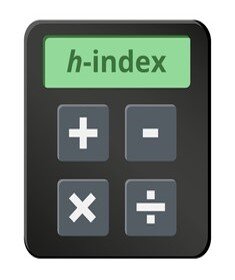مؤشر H فی Scopus


تم تطویر مؤشر H بواسطه الفیزیائی خورخی إ. هیرش، وهو مقیاس مقبول على نطاق واسع لتقییم تأثیر عمل باحث واحد. یمکن تقییم إنتاجیه الباحث وتأثیر استشهاداته باستخدام مؤشر H فی Scopus، الذی یُعد من أکبر قواعد بیانات المقالات والاستشهادات. یقدم هذا المؤشر نظره عمیقه حول أهمیه وتأثیر مجموعه أعمال الأکادیمیین. إن فهم مؤشر H فی Scopus أمر أساسی للباحثین الذین یسعون لتقییم تأثیرهم الأکادیمی وتتبع تقدمهم بمرور الوقت. یجب على الباحثین فهم مؤشر H فی Scopus إذا کانوا یریدون متابعه تقدمهم وتقییم تأثیرهم العلمی.

یتم تحدید مؤشر H بواسطه Scopus باستخدام إجمالی عدد المنشورات والاستشهادات للباحث. یتم استخراج بیانات النشر والاستشهادات من قاعده البیانات لتحدید مؤشر H فی Scopus. بعد ذلک، یتم تحدید أعلى رقم H الذی یملک فیه الباحث H منشورات، کل واحده منها تحتوی على H استشهادات على الأقل، ویتم استخدام هذا الرقم لتحدید مؤشر H. بناءً على ذلک، فإن الباحث الذی لدیه مؤشر H بمقدار 15 یکون قد نشر 15 مقالًا، وکل مقال یحتوی على 15 استشهادًا على الأقل.

یوفر مؤشر H فی Scopus العدید من المزایا للباحثین. أولاً، توفر Scopus تغطیه شامله ومتعدده التخصصات للمقالات العلمیه، مما یضمن تمثیلًا واسعًا لتأثیر الأبحاث. یشمل ذلک العدید من التخصصات، مما یتیح للباحثین من مختلف المجالات تقییم تأثیرهم باستخدام مقیاس موحد. بالإضافه إلى ذلک، توفر Scopus بیانات استشهاد محدثه، مما یمکّن الباحثین من تتبع مؤشر H فی الوقت الفعلی ومراقبه تأثیر استشهاداتهم بمرور الوقت.

على الرغم من أن مؤشر H فی Scopus یقدم معلومات مفیده، إلا أنه من المهم أن یکون الباحثون على درایه بالقیود المرتبطه به. أولاً، لا یأخذ مؤشر H فی الحسبان اختلافات ممارسات الاستشهاد عبر التخصصات، مما قد یضر بالباحثین فی المجالات التی تعتمد على استشهادات أقل. بالإضافه إلى ذلک، قد یتأثر مؤشر H بالاستشهادات الذاتیه، وأنماط التعاون، واختلافات فی ممارسات النشر والاستشهاد عبر الزمن. یجب على الباحثین تفسیر مؤشر H فی Scopus جنبًا إلى جنب مع مقاییس أخرى وتقییمات نوعیه لفهم تأثیر أبحاثهم.

یعد مؤشر H فی Scopus أداه قیمه للباحثین بعده طرق. فهو یتیح للباحثین مقارنه تأثیرهم بأقرانهم فی نفس المجال أو عبر التخصصات. یُستخدم مؤشر H أیضًا لتحدید الباحثین المؤثرین وفرص التعاون المحتمله، مما یسهم فی فرص الشبکات والتعاون. علاوه على ذلک، یمکن استخدام مؤشر H فی Scopus فی التقییمات الأکادیمیه، وطلبات المنح، وتقییمات الترقیه، حیث یوفر دلیلًا کمیًا لتأثیر الأبحاث.

فی الختام، یعد مؤشر H فی Scopus مقیاسًا قیمًا للباحثین، حیث یقدم مقیاسًا موحدًا لتأثیر البحث استنادًا إلى بیانات النشر والاستشهادات. یوفر مزایا مثل التغطیه متعدده التخصصات، وبیانات الاستشهاد المحدثه، والقدره على تتبع التأثیر مع مرور الوقت. ومع ذلک، یجب أن یتم التعرف على القیود الخاصه به، ویجب أن یأخذ الباحثون فی اعتبارهم المقاییس الإضافیه والتقییمات النوعیه جنبًا إلى جنب مع هذا المقیاس. إن فهم مؤشر H فی Scopus یمکّن الباحثین من تقییم تأثیرهم الأکادیمی واتخاذ قرارات مستنیره بشأن مسیرتهم البحثیه.
أکادیمیه سیتا
هل أنت باحث تسعى لنشر عملک فی المجلات العلمیه المصنفه فی Scopus؟ لا تبحث بعیدًا، فأکادیمیه سیتا هنا للمساعده! فریقنا من الخبراء متخصص فی مساعده العلماء خلال عملیه النشر، مما یضمن أن أبحاثک تجد مکانها فی المجلات المصنفه فی Scopus. مع مجموعه واسعه من الخدمات التی تشمل التحریر باللغه الإنجلیزیه من قبل ناطقین أصلیین، التنسیق، فحص السرقه الأدبیه، واستخراج المقالات من الأطروحات، نقدم لک الدعم الذی تحتاجه لتعزیز فرص نجاح نشر أبحاثک فی مجلات Scopus. تواصل معنا الیوم لتأخذ بحثک إلى المستوى التالی وتحقق تأثیرًا دائمًا فی مجالک.

إذا کان لدیک أی أسئله، استفسارات، أو ترغب فی معرفه المزید عن خدماتنا، فلا تتردد فی التواصل معنا. فریقنا المخصص مستعد لمساعدتک.